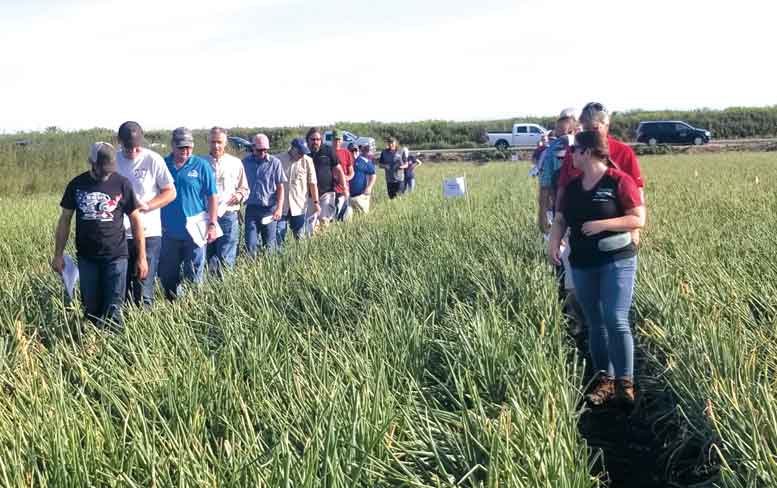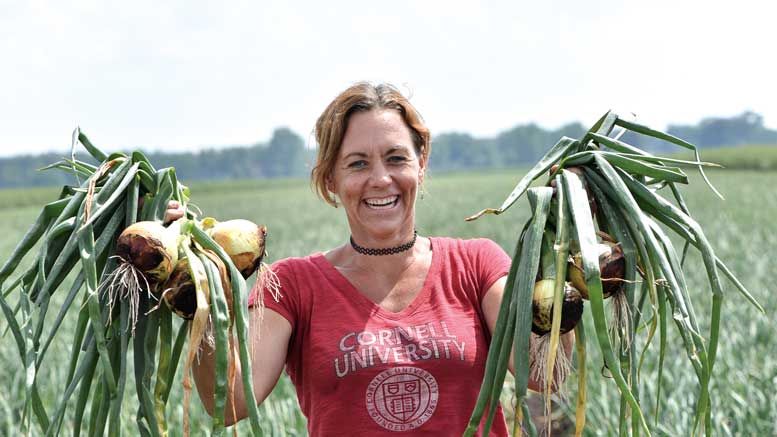|
Click to listen to this article
|
By Christy Hoepting, CCE Cornell Vegetable Program
Recent record high nitrogen prices have begged the question: How much nitrogen do muck-grown onions really need? Luxurious use of fertilizer by muck onion growers to ensure large onions and high yields (e.g., 120-140 lbs/acre of nitrogen) has been a tradition passed down through generations. This practice is hard to change because lowering fertilizer rates risks producing smaller onions. But with the cost of nitrogen fertilizer more than doubling from around $225/ton in 2020 to around $500/ton in 2022, this “cheap crop insurance” was suddenly not so cheap anymore. In addition, excessive use of nitrogen fertilizer contributes to greenhouse gas emissions that curb New York state’s ambitious climate change mitigation goals.
Trials Indicate Opportunity to Reduce Nitrogen Rates
Since 2017, Christy Hoepting with Cornell Cooperative Extension – Cornell Vegetable Program (CVP) and Brian Nault with Cornell Vegetable Entomology and their teams have conducted 11 on-farm nitrogen fertility trials in muck-grown onions, which have overwhelmingly indicated that onions can be grown on good muck soil using 60-90 lbs/acre of applied nitrogen without yield loss.
In 2017 and 2018, in two studies conducted by Nault’s graduate student Ashley Leach in the Elba, New York, muck, there were no significant differences between 60, 75, 105 and 135 lbs/acre of total applied nitrogen (urea), although all of these treatments yielded significantly ~50 percent more than zero applied nitrogen. Note that these trials were conducted in shallower muck with overhead pivot irrigation. These results suggest that 60 lbs/acre of nitrogen is sufficient.
In 2018, there were no significant differences in yield among 37, 100 and 150 lbs/acre of applied nitrogen (urea) at planting in the two CVP onion variety trials where these rates were tested with seven and 12 varieties in Elba and Oswego, New York, respectively. Note that these trials were conducted in deep muck and were not irrigated. These results suggest that 37 lbs/acre of nitrogen is sufficient.
In 2019, there were no significant differences in yield among 10, 30 and 60 lbs/acre in the CVP onion variety trial in Elba, where these rates were tested with nine varieties. It is not known whether a higher rate of nitrogen would have resulted in greater than 448 cwt/acre. In the 2019 Oswego variety trial, 60 lbs/acre of applied nitrogen had significantly higher yield than 10 and 30 lbs/acre, which were not significantly different from each other when tested across 11 varieties. Amazingly, these low rates of nitrogen yielded 986-1,124 cwt/acre, suggesting that maximum yields were achieved. Note that these trials were conducted in deep muck and were not irrigated, and that 2018 was hotter and drier than 2019. These results suggest that 30 lbs/acre of nitrogen is insufficient.
In 2020 and 2021, in the two CVP nitrogen timing trials in Oswego, there were no significant differences in yield between 60, 90 and 120 lbs/acre of applied nitrogen (urea). Note that these trials were conducted in deep muck and were not irrigated, and that 2020 was drier than 2021. These results suggest that 60 lbs/acre of nitrogen is sufficient.

In 2019, 2020 and 2021, in Nault’s “fertility mile” project, there were no significant differences between zero, half and full rates of NPK (not just nitrogen) in any year of study. For this project, growers were asked to apply zero, half and their standard full rates of NPK in ≥ 30 ft x 150 ft areas for each rate. Rates of nitrogen in the half NPK treatments ranged from 45 to 70 lbs/acre and from 89 to 140 lbs/acre in the full NPK treatments. These large-scale trials varied from being irrigated and non-irrigated, on shallow and deep muck, on rotated and nonrotated ground and among variety. There were no consistent numerical trends among NPK rates within the 21 individual trial sites. Furthermore, growers did not see differences in bulb size or foliar health in their own fields as they walked the “fertility mile” through the different rates of NPK.
There were no significant differences in nitrogen levels in leaf or bulb tissues among rates of applied nitrogen in any of the four variety or two nitrogen timing CVP trials, and no deficiencies in leaf tissue were detected.
Rate of applied nitrogen did not have a significant effect on onion thrips in any of the 11 trials or on bacterial bulb rot in 10 out of 11 trials. In the nitrogen onion thrips trial in 2017, bulb rot in 0 lbs/acre applied nitrogen treatment (1 percent) was significantly lower than it was in 60, 75, 105 and 135 lbs/acre applied nitrogen treatments (5-8.5 percent bulb rot).
Modern muck onion production systems are loaded with nitrogen. Levels of available nitrate-nitrogen (NO3-N) found in the soil at the time of onion harvest ranged from 29 to 188 lbs/acre in the five CVP trials where soil samples were collected at harvest. In these trials, the rates of applied N were 10, 30, 37, 60, 90, 120 and 150 lbs/acre. The fact that there was still plenty of NO3-N in the soil at the time high-yielding crops were harvested indicates that muck soil can be relied on to provide a lot of the nitrogen needs of our onion crops. Nitrogen is released when the organic matter in muck soil decomposes (especially in younger muck) and from the decomposing residue of previous crops (such as soybeans), cover crops and barley nurse crops. Today, nurse and fall cover crops recycle nitrogen that was previously permanently lost from the system through oxidation and erosion when nitrogen recommendations were originally made in the late ‘60s and early ‘70s.
More Important Factors Affect Yield
Growing season – The greatest differences in yield occurred among growing seasons. All trials conducted during the moderate conditions of 2019 had higher yields than trials conducted in the hotter and drier years of 2018 and 2020 and the wetter year of 2021.
Variety – The greatest differences in yield occurred among varieties, which was significant in all four CVP trials. The differences in yield between the lowest and highest yielding varieties were 26 percent, 41 percent, 24 percent and 40 percent in Elba 2018, Oswego 2018, Elba 2019 and Oswego 2019, respectively. Comparatively, the difference between lowest and highest yield in the only trial where significant differences in yield among nitrogen rates occurred (Oswego 2019) was only 12 percent. Generally, yield increased as days to maturity increased. In general, the hybrid varieties that are grown today are much more vigorous, with stronger root systems that mine nitrogen more efficiently than those that were commonly grown when nitrogen fertilizer recommendations were originally made.
Growers Successfully Reduce Nitrogen
In 2022, in response to the cost of nitrogen fertilizer more than doubling, and numerous Cornell on-farm trials demonstrating that muck-grown onions could be produced using only 60-90 lbs/acre, four New York muck onion farms reduced their rate of N fertilizer from 100-140 lbs/acre to 60-90 lbs/acre, while another farm reduced its rate from 140 lbs/acre to 120 lbs/acre in addition to reducing the broadacre rate by 50 percent by banding NPK. In total, these five farms reduced their rate of N fertilizer by 27 percent on 4,125 acres, which is equivalent to 144,795 pounds in reduced N fertilizer. This reduction saved $36,200 in N fertilizer expenses and lessened on- and off-farm greenhouse gas (GHG) emissions by 723 tons CO2eq., which is approximately equivalent to the amount of carbon sequestered in 776 acres of forests in one year, the amount emitted by consuming 64,443 gallons of diesel or the amount of energy to heat 83 homes for one year.
Funding for the trials was provided by the New York Onion Research and Development Program, Seminis Vegetable Seeds, USDA SCRI Stop the Rot bacterial bulb rot project (2019-511811-30013) and USDA SCRI Onion Thrips project (2018-51181-28435).

